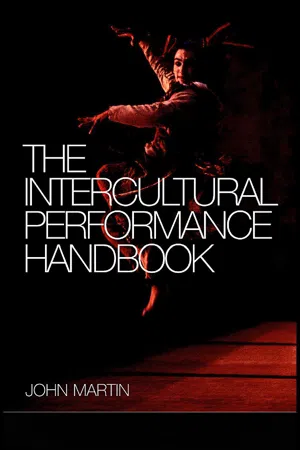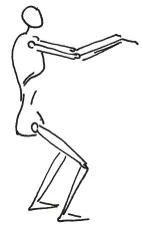1 Discovering the
energy
This chapter introduces you to the process of finding the energy we all possess within us, and shows you how to draw from that the alertness we need in any type of performance.
What do we mean by energy? It is something very practical and very useable. It is felt by the performer and by the audience.
When we see actors from Kathakali, Noh Theatre or the Beijing Opera we sense that they have an inner energy supporting the role they are playing. We often sense that this energy is much greater than that which is being used in performance, but which has huge latent potential. In Noh there is a tenet: Feel in the heart ten, but show in the body only seven. It implies that the audience should always feel that much more is possible at any moment, giving a sense of potentiality, almost of danger.
This energy is not only seen in high action. It can also be like that of a cat poised to pounce, totally still but an obvious energy held in every part of the body. This is a wonderful starting image for an actor. Even in stillness there is enormous held energy.
We also see it in a number of martial arts. The energy is ready for anything, centred, alert and constantly on ‘the edge of danger’ as performer-trainer Olu Taiwo calls it.
This alertness opens us to the feelings we need as actors and prepares us for the vital transmission of those feelings to an audience. Audiences respond readily to energy on stage. We often call it ‘presence’, but presence is only how we awaken and hold our energy.
The exercises to introduce these concepts to you cover:
- Body shape, vertical line and centre
- Stability
- Breathing – on the second element of energy
- Breathing – centred for energy – jumps
- Resistance
- States and energies within the breathing
- Energy and eyes
- Energy in kneeling and sitting.
BODY SHAPE, VERTICAL LINE AND CENTRE
Exercise 1 The empty pot
Preparing for the work of performance.
This is adapted from an exercise taught by a Kabuki actor. It helps you to be aware of the shape of your body in space, and see it as a receptacle for the characters and creative ideas which will fill it. It is an excellent exercise to start the day.
Stand with your feet slightly apart, arms relaxed, eyes closed. Feel as if you are emptying yourself. Release any tensions, empty any thought or cares from the outside world. Be like an empty pot.
Then, feeling the feet firmly on the floor, be aware of the shape of the body (the pot) into which impulses will flow, through which expressions will flow. Feel the outside surface of your body. Mentally trace it from the soles of your feet up the front of your body, over your head and down the back of your body to the ankles. This is the shape you make in space.
Breathe freely into this empty space, as if the breath were flowing into every part of it from the tips of the toes to the top of the skull. As you breathe deeper you will feel a slight inner pressure of air inside this prepared body. The breath is giving you the first feeling of your latent energy. It is filling you.
Without losing this feeling open the eyes – take in the impulses around you. See them as new, as if for the first time.1
Exercise 2 The rope
Adapted from a Native American director’s exercise shared at The Commonwealth Theatre Laboratory, Bhopal.
Feel the feet firmly on the floor. Feel the spine growing upwards as if it is part of a rope stretching from the centre of the earth up to the sky. You are on this line wherever you go. Feel the pull up through the spine to the sky, and from the base of the spine down through the legs into the earth. They are opposing pulls along the vertical. Feel the energy of this opposition and the energy up and down this vertical column.
This is a very basic awareness of the extra energy ‘born’ of a simple counter-tension, in this case between up and down.
Exercise 3 Running on the rope
Start a gentle run on one spot, still feeling the same verticality, the heels touching the ground on each step and the spine still stretching upwards (on that rope). The shoulders, ribs and pelvis are not tense, nor over-relaxed, but suspended from the vertical. Avoid any sideways wobbling. The feeling is of energy being gathered on each downbeat of the heels as if the ground is a ‘battery’ from which to draw power – rising up each leg to meet at the base of the spine – rising up the spine to leave through the eyes, as if the eyes are an extension of the spine.
Exercise 4 Centring
Continue the run as above. Vigorously massage the abdominal area from just above the navel down to the top of the pubic bone and round to the base of the spine, as if you were wearing a belt of energy. You will feel the blood flowing there. Keeping that awareness drop from the run into a low centred position (see Figure 1.1), knees bent (knees vertically above the feet), legs open and spine still vertical. The eyes are alert, the arms open and the legs are like a sprung spring. The energy is centred in the abdomen and base of the spine where you massaged. From the run this drop should be very strong but very light, the landing should be like a cat’s – virtually soundless and ready for any subsequent action. If you drop too heavily, and thus noisily, the downward energy prevents a state of readiness.
Practise constant changing between the vertical running and the centred position. On landing in this very important position there is a sense of anticipation, of readiness (it is very still and very charged) as this is a position from which action can begin. You are experiencing the powered position which has drawn theatre-makers to realise the energy of stillness inherent in so many styles of theatre from Topeng to Kathakali, and common in many martial arts forms.
From such a position you can run, jump, fall or twist in an instant.2
Extensions
- Move around the space in a gentle run. On a given signal drop into this centred position.
- Move around the space, running. Drop into the centred position in your own timing, whenever you feel an impulse. For example you may hear something, become aware of a change in light, meet someone’s eyes; all these are impulses to drop into the centred position. You may end up facing someone or something. What is your relationship to it?
Front
Side
Figure 1.1 The centered position
3 Note then how you leave this position to continue running. You have to leave the state of heightened tension very carefully, not just walk out of it.
4 Repeat 2 but walking sometimes fast, sometimes slow, ready for the impulse to ‘centre’.
Feel that you carry this centred position in you wherever you go, ready for use.
STABILITY
The strength of the centred position should not be stiff or rigid. Indeed it is not really strong and certainly not stable if it is rigid. The strength should be as of rubber, not of glass. Glass is strong but, as it cannot bend, it will smash. Rubber will give and spring back if pushed.
Therefore if an impulse (a firm push) is given to any part of the body you should be able to accept it, go with it, and return to the centred position, like rubber. This needs a great mobility of the centre. Effectively whatever part of the body is pushed it is counterbalanced either by the pelvis or torso moving either side of a centre-of-gravity line and then returning. If the body reacts strongly and fluidly then the feet do not move and you maintain a strong, workable, stable position, and you feel that you are always in control of your energy.
Pushes to the abdomen, chest, shoulders, under the chin or to the sides of the head and pulls to the arms or from behind the head and shoulders are all possible (see Figure 1.2).
Exercise 5 Stability game
Bringing the energy into play.
Two people stand facing each other in the deep centred ...


